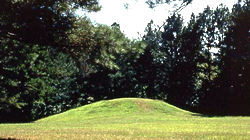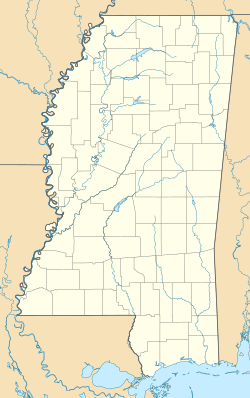Bynum Mound and Village Site facts for kids
Quick facts for kids |
|
|
Bynum Mound and Village Site
|
|

A mound at Bynum
|
|
| Nearest city | Houston, Mississippi |
|---|---|
| NRHP reference No. | 89000783 |
| Added to NRHP | July 16, 1989 |
The Bynum Mound and Village Site is an ancient place in Chickasaw County, Mississippi, near Houston, Mississippi. It was used by people during the Middle Woodland period, which was a long time ago, between 100 BC and 100 AD. This site has six large burial mounds. These mounds were built by people of the Miller culture. The Bynum Mound site is now a protected historical place. It was added to the National Register of Historic Places in 1989. You can find it along the Natchez Trace Parkway.
Contents
Exploring the Bynum Mound Site
The Bynum Mound and Village Site covers about 6 hectares (15 acres). It sits on a low ridge overlooking Houlka Creek. This creek flows into the Tombigbee River. The site has six cone-shaped burial mounds. These mounds range in height from about 5 feet (1.5 meters) to 14 feet (4.3 meters). The people who lived here built and used these mounds between 100 BC and 100 AD.
In the 1940s, archaeologists from the National Park Service dug into five of the mounds. After their work, the two largest mounds were rebuilt. Today, the site is open to visitors. There are signs that explain its history.
What Archaeologists Found
During their digs, archaeologists found interesting items. Some of these items were made from materials not found in Mississippi. These include greenstone, copper, and galena. They also found special arrowheads. These items show that the people at Bynum were part of a large trade network. This network is known as the Hopewell exchange system. It connected many different groups of people over long distances. Similar valuable items were also found at the Pharr Mounds. This is another ancient site nearby.
Mound A Discoveries
In Mound A, archaeologists found the remains of a woman. She was buried between two burned oak logs at the bottom of the mound. They also found decorative copper spools near her wrists. The remains of two adult men and a child were also found in this mound.
Mound B Discoveries
Mound B is the biggest mound at the site. Inside, archaeologists found a special pit lined with logs. This pit was used for cremation. They discovered 29 polished greenstone tools called celts. These tools were arranged in an L-shape. Human remains were also found here. Some were cremated, and others were not. They lay on the ash-covered floor of the pit. Other special items included copper ear-spools. They also found 19 chert arrowheads. These arrowheads are thought to have come from Hopewell people in Illinois. A piece of galena was also found.



